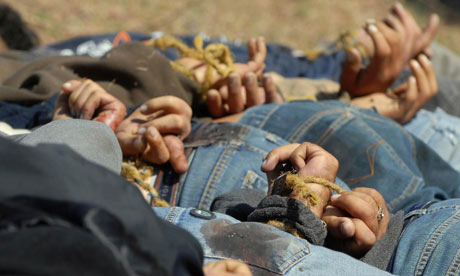The recent release of murder statistics for 2014 in Mexico reveals that the North’s longstanding role as the primary driver of bloodshed is declining against the backdrop of a nation significantly safer than in years past.
Much of the initial attention on the new publication from Inegi, Mexico’s statistical agency, has focused on the broad gains in security. The nation as a whole registered 19,669 murders in 2014, which represents a rate of 16 homicides per 100,000 residents. In both statistics, 2014 delivered the best figures since 2008. Overall murders have plummeted by 28 percent from a high in 2011 of 27,213.
The statistics were especially encouraging in Guerrero, Mexico’s most dangerous area for the past few years. With 1,719 murders, Guerrero remains the most violent state, but that figure represents a decline of roughly a quarter from 2013.
Assuming the data is accurate, these numbers reflect a positive narrative that runs counter to a series of high-profile security catastrophes that that have emerged in recent months. The most prominent security stories of the past 12 months remain the escape of Joaquin “El Chapo” Guzman, the disappearance of 43 students in Guerrero, and the alleged army massacre of suspects in Mexico State. Each of those incidents, all of which implicated officials at different levels, remains an embarrassing black eye for the government led by President Enrique Peña Nieto.
The Inegi figures demonstrate that, scandals notwithstanding, not all news in Mexican security is unhappy.
But beyond the obvious headline finding, perhaps the most striking aspect of the Inegi report is the pacification of northern Mexico since 2010. While the traditional role of criminal groups in northern Mexican society will not disappear, and while the North’s proximity to the US border will continue to make it a vital region, this years-long trend suggests that the region is shedding its role as epicenter of organized crime bloodshed.
InSight Crime Analysis
Mexico’s six border states Baja California, Sonora, Chihuahua, Coahuila, Nuevo Leon, and Tamaulipas, plus adjacent Durango and Sinaloa, represent the historical home of Mexican organized crime. Virtually all of the most powerful groups in recent decades — among various others, the Juarez Cartel, the Sinaloa Cartel, the Gulf Cartel, the Zetas, and the Arellano Felix Organization — called these states home. The plazas within this region included Mexico’s most valuable, and the groups mentioned above have long waged war to control them.
SEE ALSO: Mexico News and Profiles
All of these states saw their total number of killings drop from last year. In most of them, the drops were substantial. Nuevo Leon and Coahuila, for example, registered drops of 40 and 45 percent, respectively. With the exception of Sonora and Baja California, each of these states registered their most violence-free year since 2010.
In 2014, they accounted for just 6,335 murders out of a national total of 19,669, just over 32 percent. This is a slight decline from last year, in which the eight states registered 34 percent of the total nationwide, but it represents a massive drop from the acme of Mexico’s recent battles with organized crime. In 2010, for instance, the group registered 14,540 killings, most of which were the product of organized crime conflicts. This came against a national figure of 25,757, meaning that the North, which is home to just a fifth of the Mexican population, generated 56 percent of the nation’s murders.
Since then, the number of killings in the North, as well as their proportion of the national total, has dropped every year. In 2011, the region’s 12,885 killings represented 47 percent of the nationwide sum of 27,213. The following year, the 10,648 murders in northern Mexico accounted for 41 percent of all Mexican murders. In 2013, homicides in the North declined to 7,857, 34 percent of the nation’s total.
The decline in murders in the North — down by 8,202 since 2010 — accounts for most of Mexico’s overall drop during the same period.
The winding down of several conflicts across the North largely explain the increased tranquility. The most prominent is the years-long battle for control of Juarez between the Sinaloa Cartel and Juarez Cartel and their respective allies. The organization controlled by Guzman essentially emerged on top, making the border town, once the world’s most violent metropolis, a far calmer place.
While the rivalries remain in place, the Sinaloa Cartel’s battles with the Beltran Leyva Organization, which sparked waves of bloodshed in Sinaloa and elsewhere in Mexico starting in 2008, and the Zetas dispute with the Gulf Cartel, a driver of violence across the Northeast since 2010, have also eased.
This demonstrates that pacifying the North remains a big key to maintaining a safe Mexico. If the inevitable gang rivalries are simmering rather than exploding, as they are now, then the region and the nation can hope to avoid a recurrence of the spiral of violence it suffered from 2008 through 2011.

